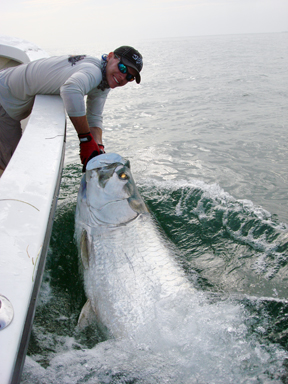
Catching silver kings great fun on fly rods
From the desk of the FWC, By Stan Kirkland
The coastal waters of Florida are home to a wide variety of fish but tarpon have few equals when it comes to strength and jumping ability. Commonly called “silver kings,” tarpon are found all along the Gulf Coast in the summer months and as far north as Virginia on the Atlantic.
Tarpon can grow to 8 feet in length and weigh up to 280 pounds. They’ll eat anything from minnows to pinfish to mullet and crabs.
There are increasing numbers of tarpon guides, particularly on the northern Gulf Coast, who cater to clients wanting the thrill of catching a big tarpon. In the Panhandle, they fish for tarpon in Apalachee Bay off St. Marks, Apalachicola Bay, St. Joe Bay and the Crooked Island area at Tyndall Air Force Base. Note: Looking for a Walton area guide? Contact Shallow Water Expeditions.
While a number of marine fish are prized for the taste and texture of the meat, that’s not the case with tarpon. Tarpon are boney and they are usually released. Those who do want to harvest or possess a fish must first obtain a $50 harvest tag from the Florida Fish and Wildlife Conservation Commission (FWC).
The anglers and guides who target tarpon can help fisheries scientists at the FWC’s Fish and Wildlife Research Institute and at Mote Marine Laboratory gather valuable information by participating in the Tarpon Genetic Recapture Study. Participating anglers collect DNA samples from each tarpon they catch and then ship those to the study team.
Each tarpon has a unique DNA “fingerprint” and the samples tell the researchers which fish have been captured before. In 2010, anglers provided more than 3,100 tarpon DNA samples. Researchers say approximately one out of every 100 fish is a recaptured tarpon.
Anglers who are willing to assist in the study can obtain an easy-to-use tarpon DNA sampling kit by emailing TarponGenetics@MyFWC.com, or by calling 800-367-4461.
It’s one thing to catch a tarpon on a rod and reel, where landing the fish can take an hour or more. However, hardcore tarpon fishermen say there’s nothing like catching one on a fly rod.
It may be the longest fly rod battle ever but in the late 1980s Crystal River resident Jim Farrior, who at the time worked for the former Game and Fresh Water Fish Commission, was fly fishing for tarpon one summer day about noon near Pine Island in Hernando County when he spotted a “string” of tarpon.
He put his fly in front of the group and a big tarpon inhaled it. Farrior stood on the bow of the 18-foot boat and held on to the 9-foot fly rod as the tarpon took all the fly line down to the backing. Farrior’s fishing buddy at the controls cranked the boat, allowing Farrior to recover his line.
“He was such a beast. I didn’t know if we would ever get close enough to get a good look at him,” Farrior recalls more than 20 years later.
But, stick with the tarpon they did. The tarpon pulled the boat from Pine Island up to the Chassahowitzka River, then back to where he hooked the fish, and then practically back to the Chassahowitzka, a distance of 5-6 miles.
Finally, at midnight, Farrior could see the tiring 200-pound plus tarpon just a few feet in front of the boat and then his 16-pound tippet snapped. After a 12-hour bruising battle, the tarpon swam away in the darkness.
“I was beat, my hands hurt, and my gut hurt (where he had to bury his rod) but it was the most amazing thing. I was just as happy as if I had put him in the boat,” Farrior said. “But, it’s fishing and why we keep coming back.”
